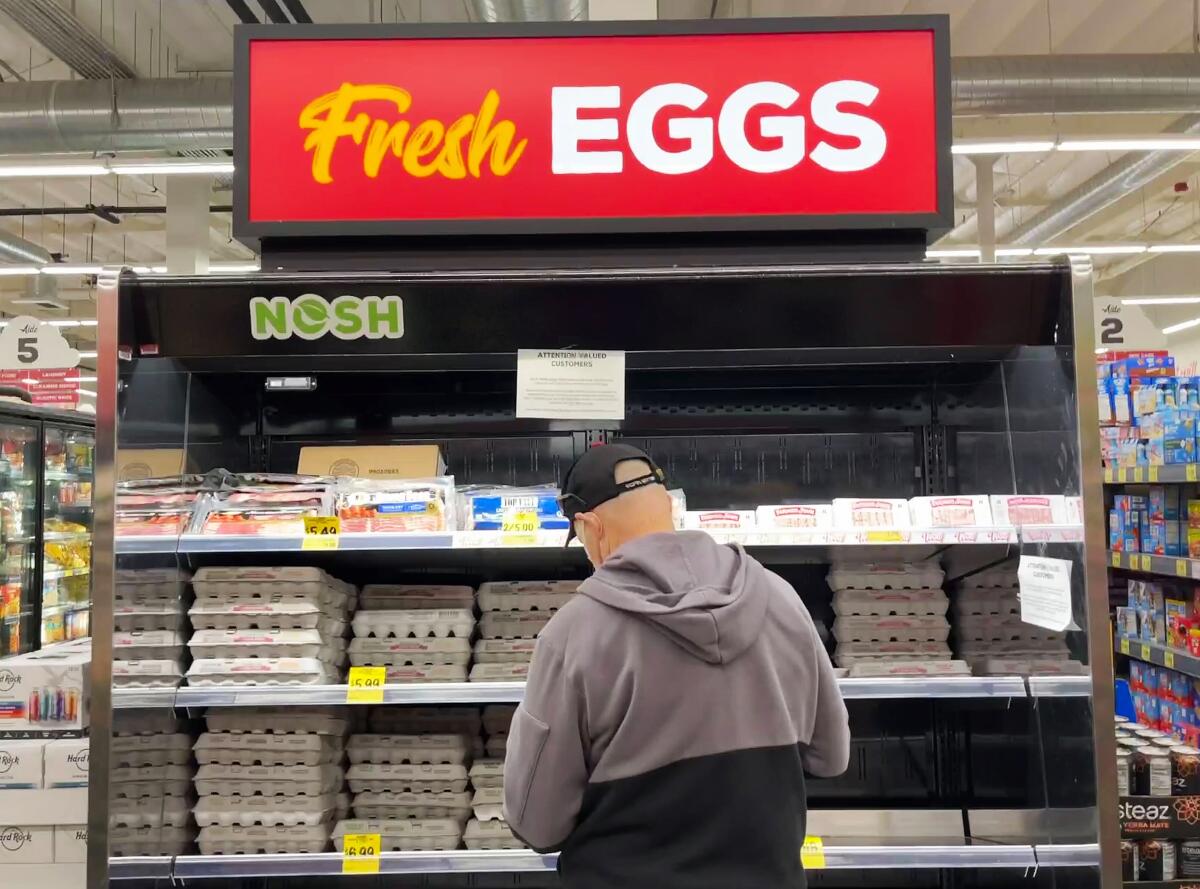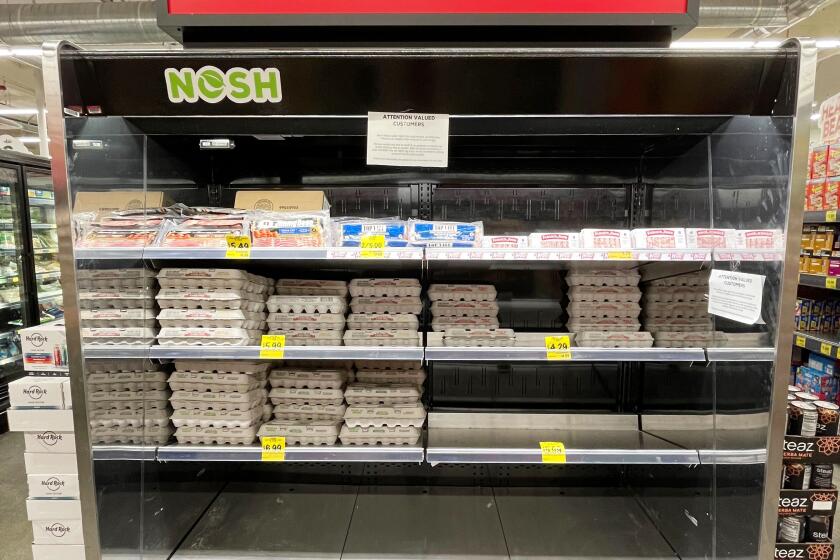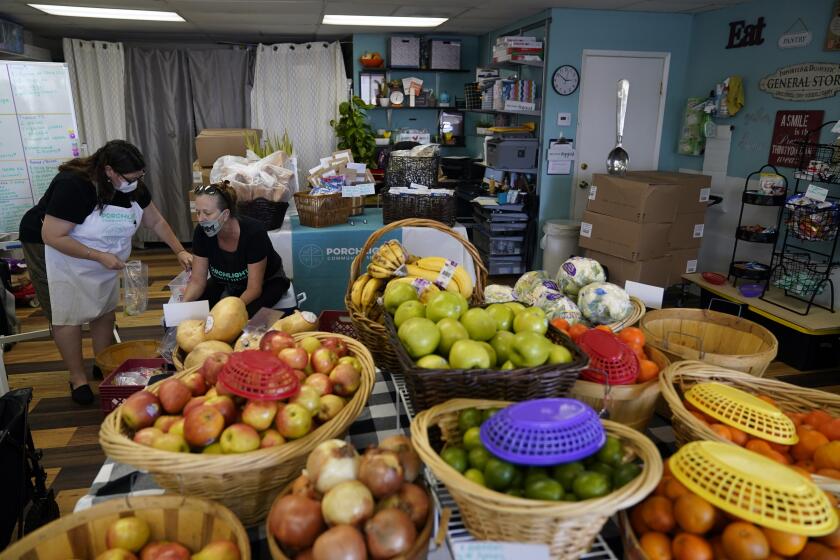Why does California have an egg shortage?

- Share via
California is experiencing a massive egg shortage. Average retail prices jumped last week to more than $7 per dozen — a $5 increase from the same time last year. Many stores ran out of the staple entirely.
One reason for the shortage is that bird flu continues to ravage farmed bird populations across the U.S. The deadliest bird flu outbreak in U.S. history has already killed more than 50 million birds nationally. Birds have died not only from the virus but also, in most cases, from humans killing them to keep the virus from spreading further.
Another reason for the shortage is that several states are implementing bans against the sale of eggs from caged birds. These policies follow on the heels of California’s 2018 ban, which took effect last year. As national demand for cage-free eggs spikes, it places even more strain on the limited supply.
Golden State shoppers are shelling out extreme prices for eggs, amid an outbreak of bird flu that has left grocers struggling to stock cartons.
Many people see the shortage as a temporary setback. In this view, it might take time for California and other states to rebuild their egg supply. But if we can weather the bird flu outbreak and increase production of cage-free eggs, then we can return to a status quo in which eggs and other animal products are plentiful.
However, this view is short-sighted. The reality is that large-scale animal farming is unsustainable. If we keep farming animals at this scale, disruptions like the egg shortage will keep happening. The current price spike is simply revealing, and dramatically exposing consumers to, a problem this industry has always faced.
The scale of animal farming is hard to imagine. At any given time, more than 2 billion farmed animals are estimated to reside in the U.S., not including fish or insects. And since it would be impossible to farm that many animals on small non-industrial farms, an estimated 98% of these animals reside in large industrial farms known as factory farms.
Factory farming is, unavoidably, very bad for animals. In typical cases, we breed farmed animals to produce as much meat, as much milk or as many eggs as possible, which can cause a variety of health problems for the animals. We often then mutilate them without anesthesia, house them in crowded, stressful conditions and kill them on industrial “disassembly” lines that prioritize speed over animal or worker welfare.
And factory farming is bad for humans. Forcing thousands of animals to live together in toxic buildings, while administering antibiotics to stimulate growth and suppress disease, creates ideal conditions for pathogens such as bird flu to spread. Factory farms also produce an enormous amount of disease-carrying waste, which can infect workers and the public through pollution and contaminated food.
Then there are the environmental costs. In general, animal farming is an incredibly inefficient method of food production, consuming about 83% of farmland and about 56% of freshwater in agriculture worldwide, while producing only about 18% of our calories. Animal farming is also a major contributor to climate change, responsible for an estimated 14.5% of all human-caused greenhouse gas emissions.
Guest writer: Free food for all? Absolutely. In this age of abundance, it should be a human right
The U.S. government already spends hundreds of billions of dollars on the food system. That investment should be transformative.
The transition to cage-free eggs illustrates how hard it is to reduce these harms while still mass-producing animal products. For instance, cage-free systems might give farmed birds more space and make them less susceptible to catching diseases from one another. But they might also increase mortality rates for some farmed birds and make them more susceptible to catching diseases from wild birds, among other trade-offs.
Does this mean that states like California are wrong to support the transition to cage-free eggs? Not at all. Less intensive confinement can still be better, even if it might not be good enough. But it does mean that there is a limit to how much progress we can make this way.
Ultimately, if we want to build a just, resilient and sustainable food system, we need to not only reform but reduce our use of animals. We need to phase down animal farming, phase up plant-based alternatives and support farmers, workers and consumers during the transition.
Fortunately, there is a lot that we can do. For instance, in addition to banning particular animal products, governments can serve plant-based meals in public facilities and subsidize plant-based foods to make them more accessible for consumers (U.S. livestock farming is itself heavily subsidized). And as our budgets and dietary needs allow, individuals can echo these choices in our own daily lives — and support policy changes that allow others to do the same.
The California egg shortage is a reminder that as long as animal farming remains at the center of our food system, that system will remain at the center of our global welfare, health and climate problems. Our task, therefore, is not to fight for a world in which meat, eggs and dairy can be constantly abundant. Our task is instead to fight for a world in which scarcity of these products is no longer a problem.
Jeff Sebo is a clinical associate professor of environmental studies, affiliated professor of bioethics, medical ethics, philosophy and law, and director of the Animal Studies Master of Arts Program at New York University. His most recent book is “Saving Animals, Saving Ourselves.”
More to Read
A cure for the common opinion
Get thought-provoking perspectives with our weekly newsletter.
You may occasionally receive promotional content from the Los Angeles Times.












